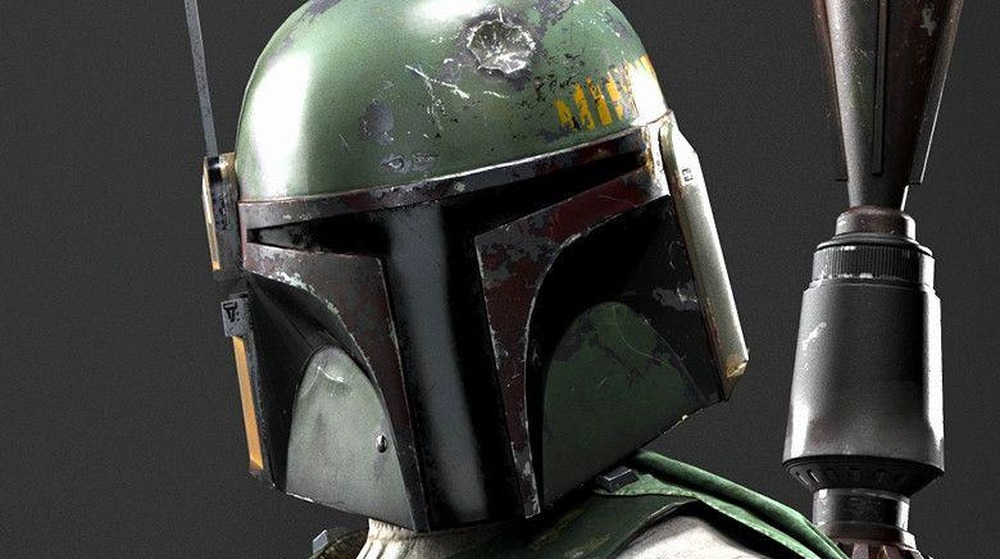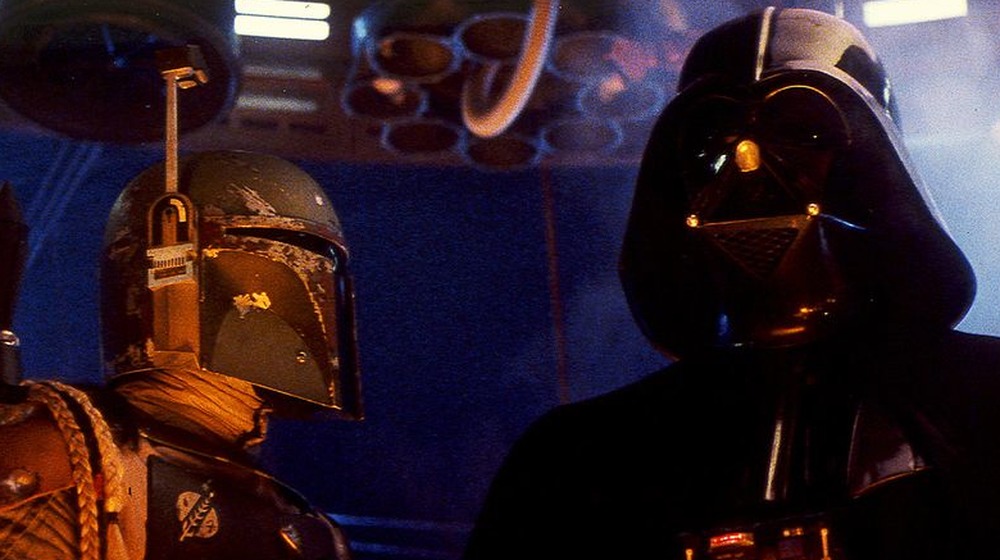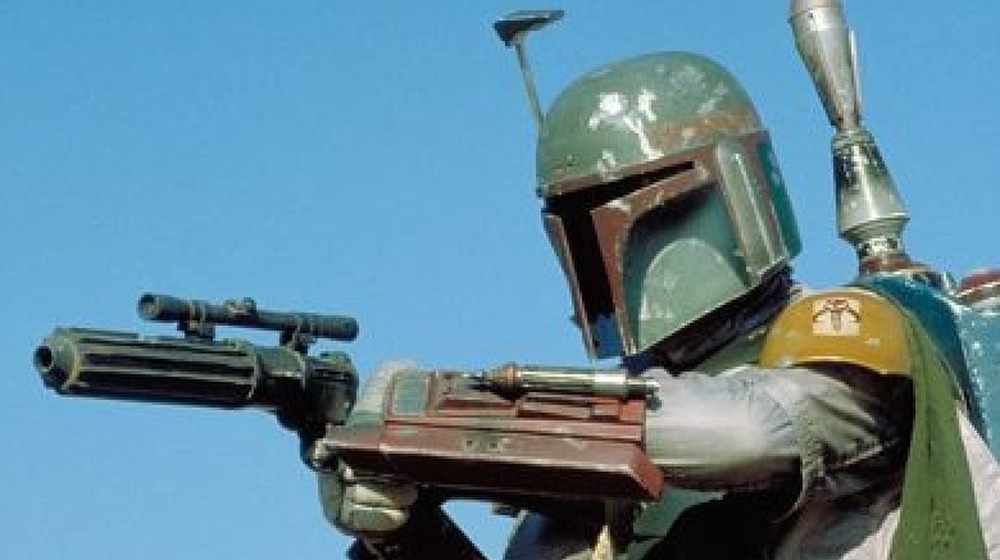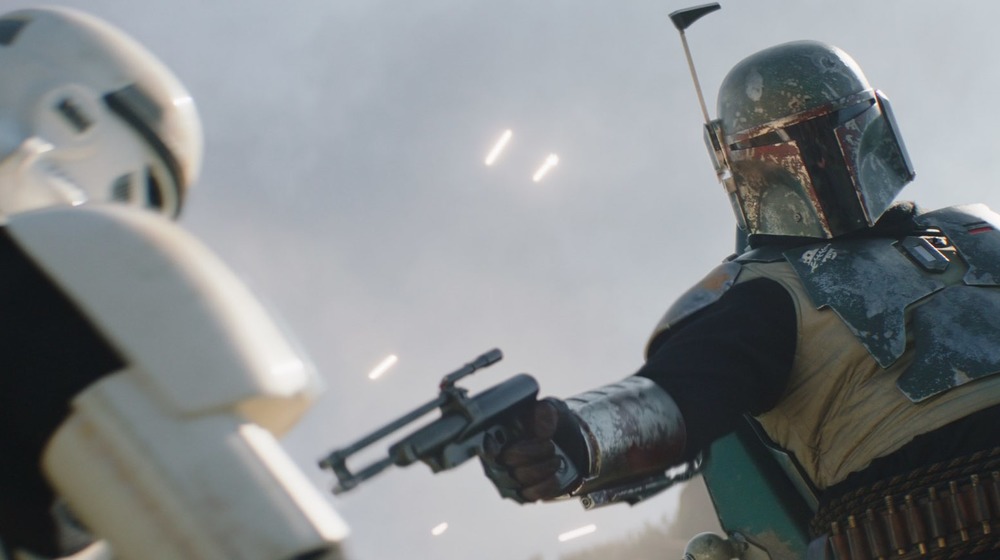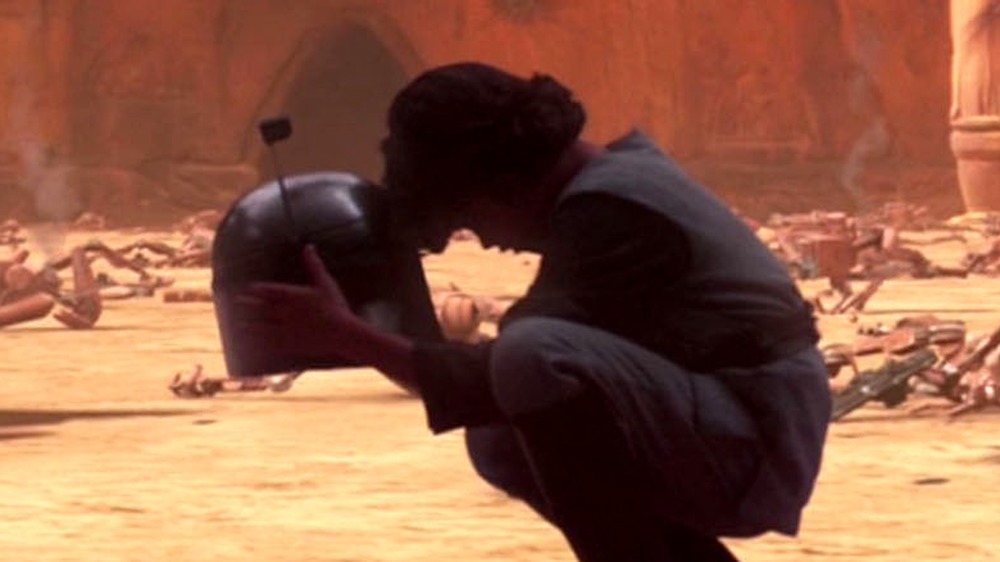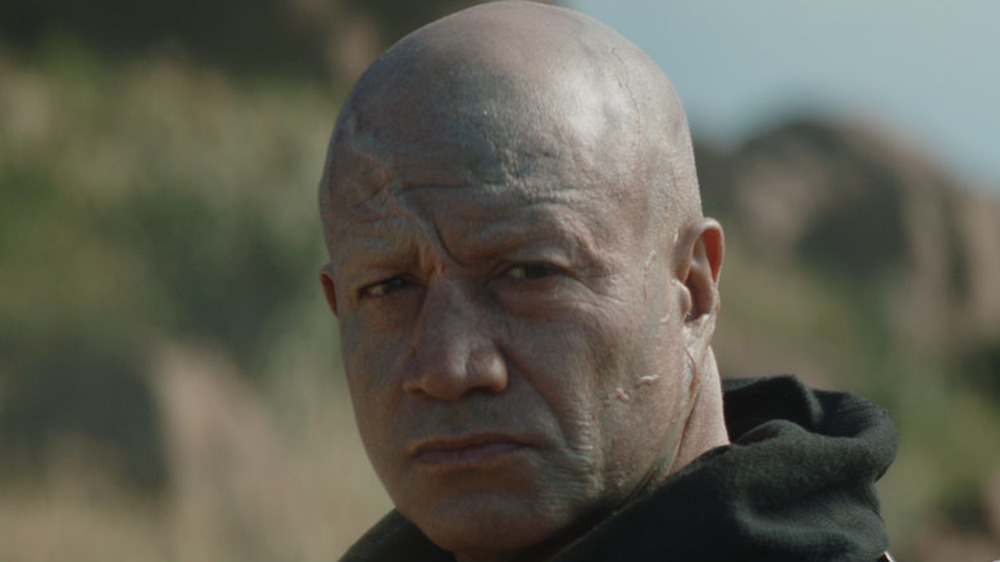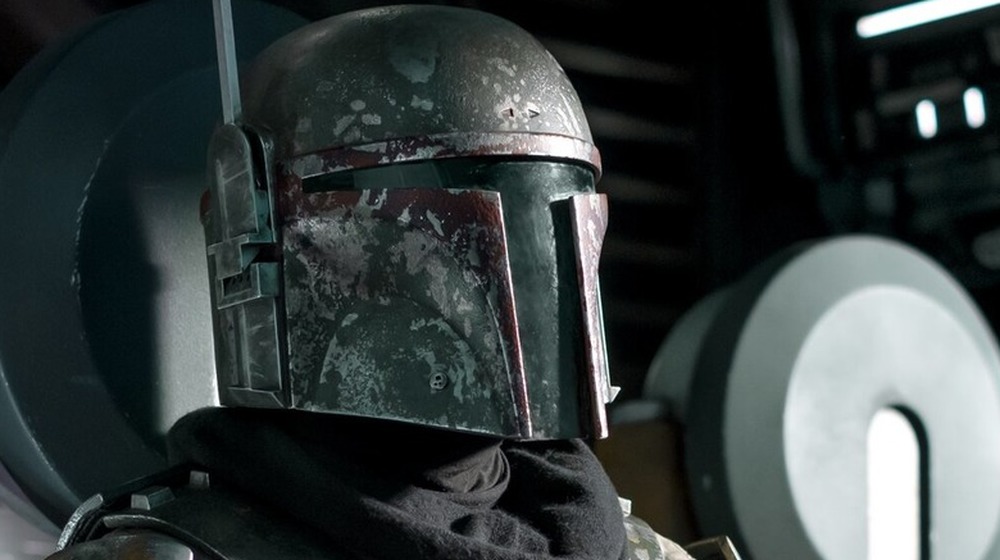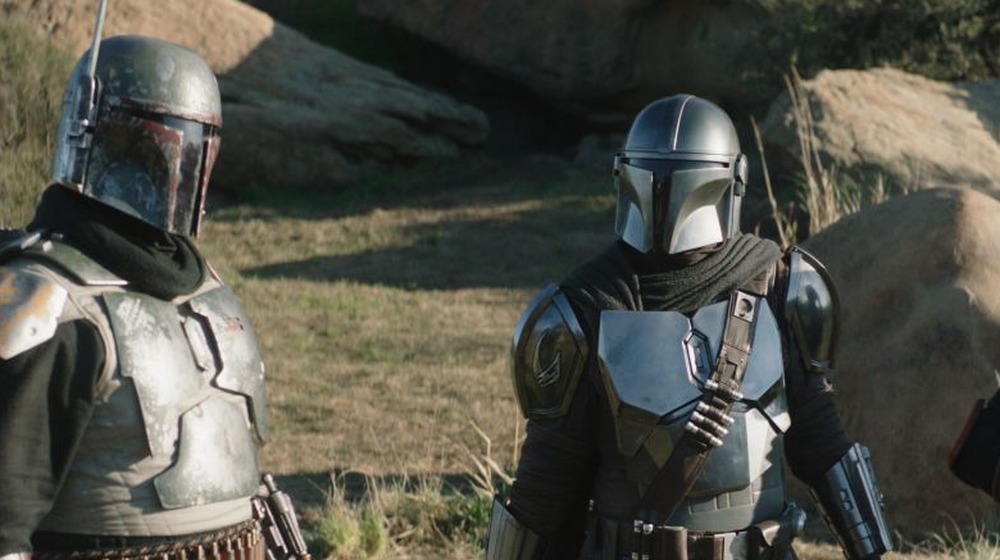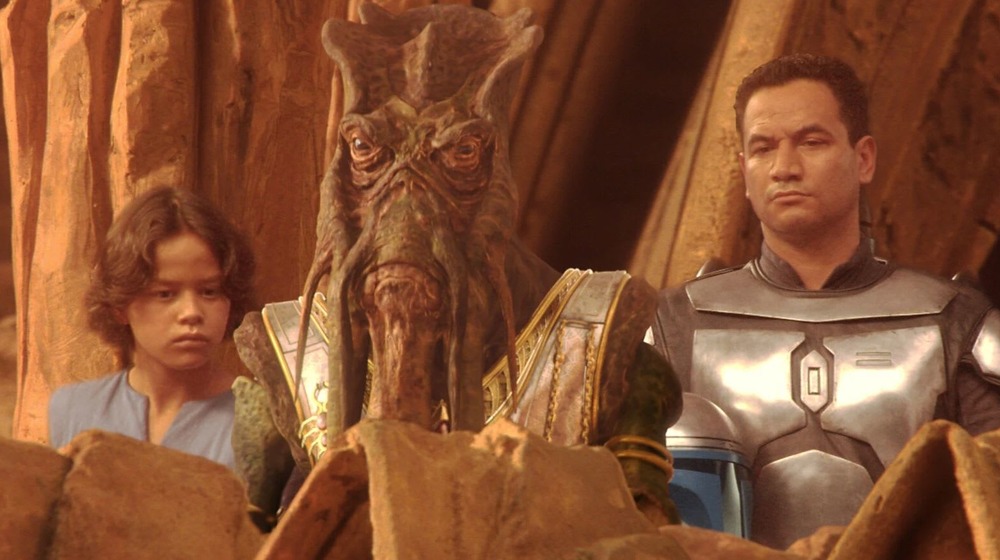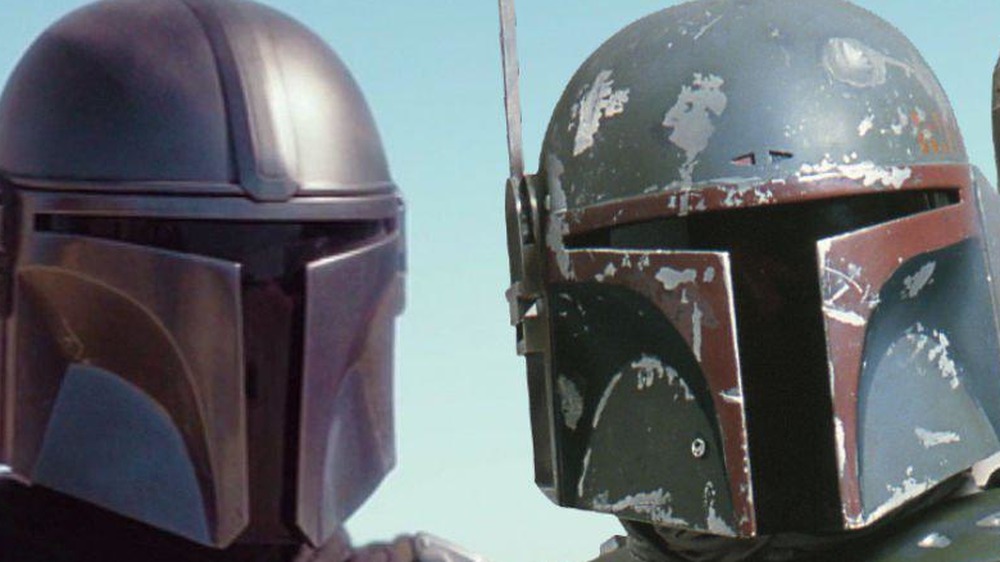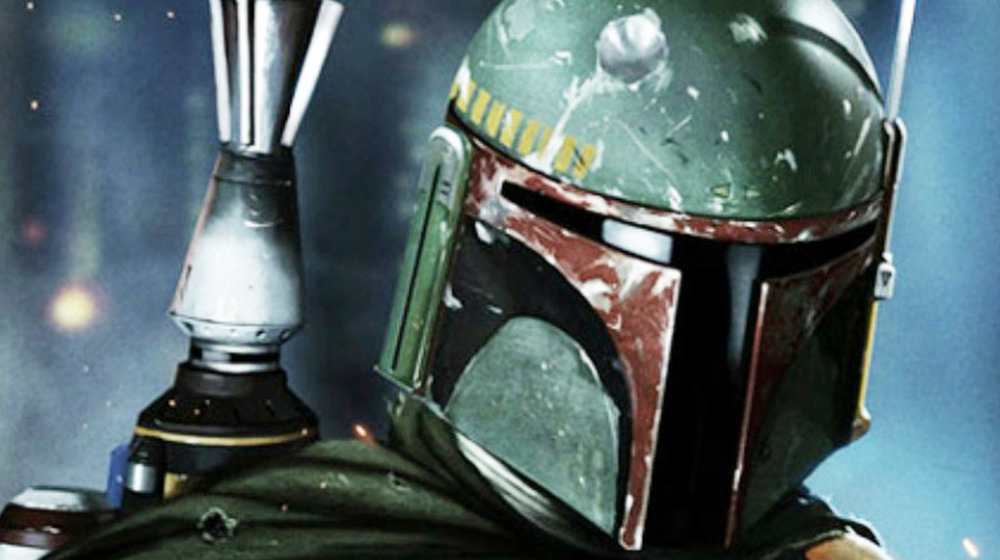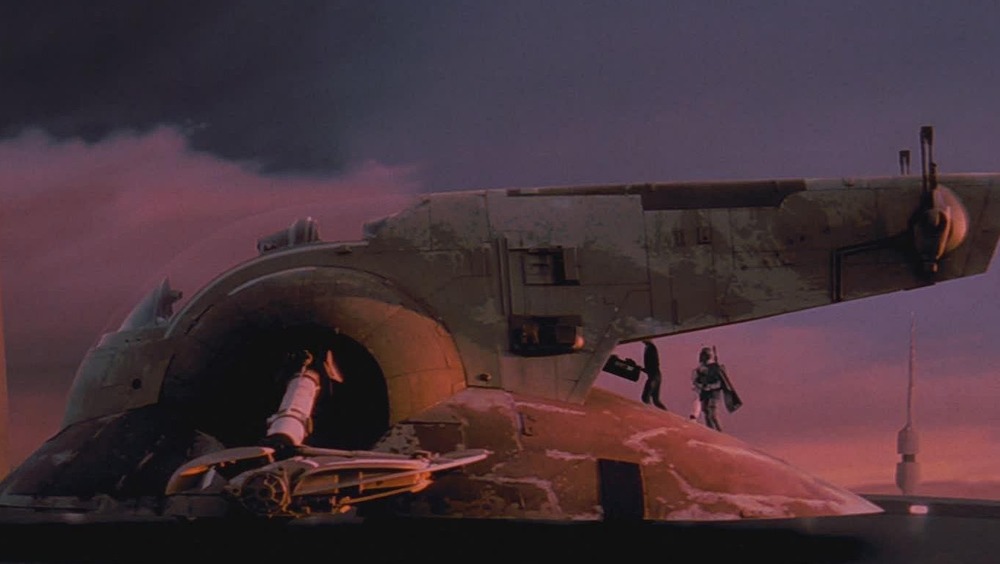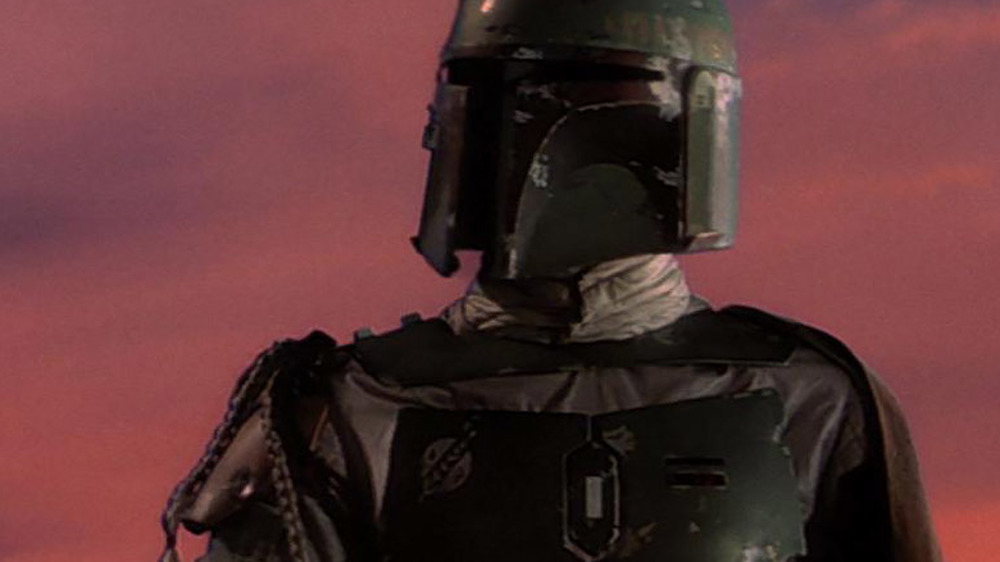Rules Boba Fett Has To Follow In The Star Wars Universe
For a character who was only given four lines and just over six minutes of screen time in the entire original Star Wars trilogy, Boba Fett has had quite the incredible journey from bit player to enduring fan favorite and major worldwide cultural icon. The audience quickly latched onto the mysterious bounty hunter in the cool Mandalorian armor, and subsequent novels, comic books, and films ensured Fett's story continued even after he supposedly dies in embarrassing fashion near the beginning of Return of the Jedi.
With Temuera Morrison playing Boba Fett in season 2 of The Mandalorian and receiving his own spin-off series, The Book of Boba Fett, Star Wars fans are finally seeing the infamous bounty hunter depicted properly in live action. While Fett remains a mysterious figure, his appearances in various media have gradually established a set of rules for how he should be portrayed. Let's break down each of these rules and finally figure out how to showcase the fearsome anti-hero that is Boba Fett.
He needs to be an enigma
With his concealing helmet and strong but silent demeanor, Boba Fett immediately establishes himself as an enigmatic character from the moment he shows up in The Empire Strikes Back. In these early scenes, the audience knows only that Fett is a dangerous bounty hunter hired by Darth Vader; no detail is given about his origins or non-monetary motivations.
Over the years, those origins were filled in, albeit with plenty of conflicting tales. In the non-canonical short story "The Last One Standing: The Tale of Boba Fett" from Tales of the Bounty Hunters, Boba Fett is established to be a man named Jaster Mereel. Later, when he's shown to be a clone in Star Wars: Episode II — Attack of the Clones, the Jaster Mereel character is retconned to be a Mandalorian who saved and mentored a young Jango Fett, giving him a strong canonical tie to the Fett family.
Behind the scenes, things got even more complicated. Mark Hamill revealed in a Twitter post that he once pitched the idea to George Lucas that Boba Fett could be Luke Skywalker's mother. Lucas obviously didn't care for the idea, but in the book Skywalking: The Life and Films of George Lucas, it's revealed that Lucas considered making Fett Anakin Skywalker's brother (and therefore Luke's uncle).
Even today, as canonical stories establish Fett's clone origins and show his unmasked face, Boba Fett remains a mysterious figure. The Book of Boba Fett may reveal more fragments of the bounty hunter's unknown past, but there will likely always be mystery surrounding his life and the various chapters of his saga.
He needs to use gadgets
Mandalorian bounty hunters are notoriously well prepared, known for keeping their armor stocked with multiple hidden weapons and traps. The Mandalorian reveals these bounty hunters use many standard gadgets, including the famous "whistling bird" guided munitions, fibercord whip, and flamethrower utilized by the show's main character. In the episode "Redemption," it's established that most Mandalorians are trained in the act of using a jetpack, an art known as the "Rising Phoenix."
Boba Fett, though, has a special relationship with deadly gadgets. Fett's jetpack comes complete with a missile that can take down entire ships (or multiple ships, if he aims correctly). His armor comes equipped with special knee rockets he can fire while walking toward his targets. In several non-canonical stories, it's established that Boba Fett's signature helmet, aside from looking cool, also gives him 360-degree vision. While this didn't seem to help him avoid Han Solo's blind attack in Return of the Jedi, this feature may make a return in Fett's new canonical stories.
Considering how Boba Fett's armor makes him a one-man army, it's no wonder that Marshal Cobb Vanth was reluctant to part with the armor in the season 2 Mandalorian episode "The Marshal." Even among Mandalorians, Boba Fett's tools make him a force to be reckoned with.
He needs to use excessive force
The Star Wars universe is a rough place. With so many Stormtroopers, Sith Lords, and Jedi ready to shoot you in the back or amputate you with a lightsaber, you need to know how to handle yourself. This is particularly true for bounty hunters who work in — or for – the worst hives of scum and villainy.
Boba Fett, however, makes fighting dirty downright filthy. Initially, this was only hinted at in The Empire Strikes Back when Darth Vader singles out Fett by warning him "no disintegrations." In the canon comic book story Star Wars: Age of Republic —Jango Fett #1, a 10-year-old Boba executes two experienced bounty hunters when they try to take him hostage.
But it's in The Mandalorian season 2 episode "The Tragedy" that we learn how merciless Boba Fett is with his targets. Stripped of his armor, Boba uses a Tusken Raider gaderffii stick against a squad of Stormtroopers who probably all wish he would just disintegrate them. Fett caves in their skulls and brutally impales them with his melee weapon, giving them the most painful-looking deaths in Star Wars history. Later, he recovers his armor and takes out the remaining Stormtroopers with bombs, blaster shots, knee rockets, and a very well-placed jetpack missile. By the end of this scene, everyone knows that when Boba Fett has you in his sights, you can forget about running away. You're already dead.
He must overcome impossible odds
Star Wars characters regularly encounter no-win scenarios. The Rebels need to blow up the seemingly indestructible Death Star (twice). Luke Skywalker needs to kill his father and somehow remain untainted by the Dark Side. And then there's Boba Fett, whose entire life appears to be a no-win scenario.
While Boba receives training and guidance from his father Jango for the first few years of his life, he essentially needs to make it on his own from the age of 10 after he's orphaned in the Battle of Geonosis. Worse, he chooses to make it in the cutthroat world of bounty hunting. Then, at the height of his reputation, he falls into the Sarlacc pit in Return of the Jedi and must keep himself from being slowly digested over the next thousand years.
Yet somehow Fett survives all of these impossible odds, adding to the aura of danger and mystique around him. When we see him in the end credits scene of The Mandalorian episode "The Rescue," he's seemingly acquired a position of great power as the new crime boss of Tatooine, but it's basically a given that this will require him to perform even more impossible feats when The Book of Boba Fett debuts.
He must experience massive trauma
Overcoming impossible odds might make for a great story, but living through so much trauma doesn't bode well for one's mental health. Boba Fett's life is so full of horrible events that his psyche is likely even more scarred than his unmasked face.
After all, Boba doesn't just lose his father in Attack of the Clones –- he watches him get decapitated by Mace Windu and later literally cradles Jango's head in his hands. The trauma causes him to seek vengeance on Windu in the Clone Wars episode "Death Trap" by infiltrating a clone facility to get close to the Jedi. His clone status also gives him major identity issues; while he considers Jango to be his father, he doesn't like being compared to other clones, and takes major offense to those who point this out, as seen in The Mandalorian episode "The Rescue."
Then there's the time Boba spent in the Sarlacc pit. The non-canon short story "A Barve Like That: The Tale of Boba Fett" from Tales From Jabba's Palace describes how Boba made telepathic contact with the Sarlacc's other victims, experiencing their horror. Ultimately, he's able to manipulate one victim into ejecting him from the pit, leaving him alive but badly injured. While we haven't learned the canonical reason of how Boba Fett survived the Sarlacc pit, it's a given that the experience left Fett with some additional trauma. His experiences may toughen him, but they also leave plenty of lasting damage.
He needs to be his own man
Boba Fett may have initially shown up in the service of the Empire, but he quickly establishes that he's loyal to no one but himself. Shortly after capturing Han Solo for Darth Vader in The Empire Strikes Back, Fett sells Solo's carbonite-frozen form to Tatooine crime lord Jabba the Hutt in Return of the Jedi. He remains in Jabba's employ until he falls in the Sarlacc pit and then roams the galaxy alone, eventually forming a temporary alliance with Mandalorian Din Djarin against the remains of the Empire.
As Fett clearly states to Din Djarin in The Mandalorian season 2 episode "The Tragedy," "I give my allegiance to no one." Unlike Mandalorians, who follow a specific creed that dictates their actions, Boba Fett makes his own rules. This might make him unpopular with the people and groups he encounters, but for this bounty hunter, it's the only way to live.
He needs to follow his own code of honor
Of course, just because Boba Fett lives by his own rules doesn't mean he's an entirely lawless man. Multiple stories reveal that while Fett may be merciless, he will honor the terms of any deals he makes with others. Star Wars: The Galactic Explorer's Guide also establishes that while Fett may claim to have no moral code, he will follow the conditions for bringing in his bounties.
Sometimes those deals are formal contracts he makes with regimes like the Empire or powerful men like Darth Vader. Other times, they're verbal agreements he offers to bounty hunters like Din Djarin, which places him in the Mandalorian's debt until he helps him save Baby Yoda (aka Grogu). Either way, Boba Fett shows he will stand by deals made with his employers and allies.
That said, once the terms of the deal are complete or his employers try to stab him in the back, all bets are off. Fett may have been working for Darth Vader in The Empire Strikes Back, but he has no problem killing Stormtroopers or blowing up TIE Fighters in The Mandalorian once he enters into a new deal with Din Djarin. He may be a dangerous mercenary, but as long as he's working for you, Boba Fett will go the distance.
He needs to have strong family ties
Although Boba Fett acquires a partner in Fennec Shand after he saves and rebuilds her with cybernetic parts following the events of The Mandalorian season 1 episode "The Gunslinger," he usually travels alone. Nevertheless, this bounty hunter is far from a man without a past or a family. While he doesn't necessarily identify as a Mandalorian, Fett is proud of his family line and identifies strongly as Jango Fett's son.
This causes him to respond with extreme anger if someone tries to write him off as just another Clone Trooper. He gets into a violent brawl with Koska Reeves after she and Bo-Katan sneer at his clone origins in The Mandalorian episode "The Rescue." He also takes great pride in showing Din Djarin the record of his family tree stored in his armor, which just provides him with an additional reason to reclaim his famous suit.
He needs to show up other bounty hunters
Being regarded as the best bounty hunter in the galaxy means you constantly have to justify your reputation, and Boba Fett is more than up for the task. Although Darth Vader hires six bounty hunters to track down Han Solo and the Millennium Falcon, only Boba Fett has the guile and deductive reasoning to work out that Solo would try to slip away when Vader's Star Destroyer ejected its trash. This leads him to hide in the trash compartment and track Solo to Bespin.
Then there's the way Boba Fett showed up the Mandalorian on his own show. As Din Djarin and Fennec find themselves boxed in by an army of Stormtroopers, Boba Fett swoops in and proceeds to slaughter the entire battalion with seemingly no effort. Din Djarin regularly shows he's a capable fighter who can methodically take down multiple foes, but in terms of sheer ruthlessness, he's no match for Boba Fett.
He needs to wear his original Mandalorian armor
If there's one thing that distinguishes Boba Fett, it's his trademark Mandalorian armor. While there are now multiple Mandalorian bounty hunters and warriors running around the Star Wars universe, there's just something about Fett's battle-scarred green and gray armor that tells people they're in the presence of a dangerous man.
In recent episodes of The Mandalorian, Fett has cleaned up the scratches and blaster marks from his armor (although he maintains the famous dent in his helmet). His reasons for wearing this particular suit of armor are also important; while Boba Fett clearly has the means to have a new armored suit built for him, he insists on tracking down his original armor. The suit initially belonged to Jango Fett, after all, and is his strongest link to his father. For someone who's lost as much as Boba Fett, his armor truly is irreplaceable.
He needs to fly Slave I
Some characters are strongly linked to their ships. The Millennium Falcon belongs with Han Solo. Luke Skywalker gets around in his X-wing. And Din Djarin has the Razor Crest –- at least until the Moff Gideon's light cruiser vaporizes it in The Mandalorian episode "The Tragedy."
For Boba Fett, Slave I is an extension of his identity. Originally flown by Jango Fett, this modified Firespray-31-class patrol and attack craft is a deadly vessel with a huge arsenal of weapons as well as special jamming technology that allows it to evade many scanning systems. Even as a child, Boba Fett was capable of firing the ship's main blaster cannons at Obi-Wan Kenobi in Attack of the Clones, and as an adult, he makes use of all the ship's weapons, particularly its devastating seismic charges.
In non-canon Star Wars stories, Fett has had to replace the ship with several other starships, including Slave II, Slave III, and Slave IV. However, given the popularity of Slave I with fans, it's likely this will be Boba Fett's ship of choice going forward. Frankly, given Fett's reputation as the galaxy's deadliest bounty hunter, anyone who tries to vaporize this ship will likely end up with a very short life span.
He needs to take trophies from his bounties
Whereas Mandalorians like Din Djarin favor a sleek look to their armor, Boba Fett's suit is considerably scruffier. It's not just the blaster fire damage on his outfit, either. Look closely and you'll see Fett carries many trophies of his past bounties on his suit. These include the braid of hair hanging from Fett's shoulders as a symbol of his defeated prey. Early concept art also shows Fett with trophies hanging from his belt that visual effects art director Joe Johnston describes as "almost like a little collection of scalps."
Other trophies are more practical. In the now non-canon short story "Prey" from Star Wars Tales #11, Fett reveals he collects lightsabers from the Jedi he's killed, and even uses one to engage Darth Vader in a duel. While its true origin remains a mystery, the Tusken Raider gaderffii stick Boba Fett wields in "The Tragedy" is very possibly another trophy Fett took from a victory on Tatooine. Given all of this, it's no wonder that Boba Fett action figures are so popular among toy collectors. Fett isn't just a collectible; he's a fellow collector.
